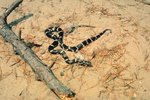Snake scat resembles the droppings of like-sized carnivores. Usually tubular in form and often tapered at the tips, the scat may occur as one piece or it may be broken into several. Very small snakes produce scat that measures less than half an inch in length; large constrictors can produce larger feces than dogs and other similarly sized animals can.
Urates and Indigestible Items
An important clue to identifying snake scat is observing urates along with the feces. Urates only accompany the scat of reptiles, including lizards, turtles and birds. The urates are the byproducts of protein metabolism, and are essentially dehydrated urine. Urates are white to pale yellow in color and vary in consistency -- they may be semi-liquid pastes when fresh, but they may also resemble white rocks or chalk. Sometimes, undigested prey remains, such as fur, teeth or claws, may be visible in the droppings.
Likely Locations
Snakes may leave droppings anywhere they travel, so look along overgrown areas in your yard, against the sides of buildings and around rock or log piles. Exercise caution when looking for snakes or signs of their presence. You may also find tracks snakes have made in loose substrates, such as sand, or their shed skins. Never place your hands or feet in a location that you cannot see, and wear sensible clothing, including thick, leather boots. If you find a snake and wish to have it removed from your property, call a wildlife professional; do not attempt to catch the snake yourself.
References
Photo Credits
-
Design Pics/Design Pics/Getty Images





